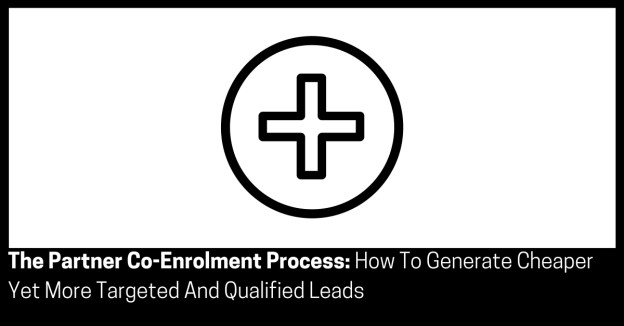Approximate read time: 6 minutes
It goes without saying that most brands with products, services or solutions are looking for cheaper yet more targeted and qualified leads for their brand.
Think about it, if you can get more targeted and qualified leads but for cheaper than normal, your cost of the sale goes down and your profit margin goes up.
Brands, of course, pursue the most obvious and reliable channels to generate their leads.
The problem with this is that they are obvious and reliable to other brands.
And being obvious and reliable means are expensive and saturated marketing channels.
This leads to less targeted and qualified leads and the price gets driven up.
Not ideal.
When brands look to uncommon lead generation strategies they benefit, as very few are playing in the same sandbox.
The concepts of “Symbiotic Marketing” and “Co-Enrolment” are two examples of effective yet uncommon lead generation marketing strategies.
Not only do they generate leads but they also generate leads that are targeted and qualified.
They are also considerably cheaper than other marketing channels.
Sounds pretty powerful, right?
So who is Co-Enrolment via Symbiotic Marketing for?
- Any brand that wants to generate more leads;
- Any brand that wants to generate more targeted and qualified leads; and
- Any brand that wants to generate cheaper yet more targeting and qualified leads.
Best of all, it’s probably for you!
So what is “Symbiotic Marketing” and “Co-Enrolment”?
“Symbiotic Marketing” is a marketing strategy where two or more complimentary but non-competing brands combine their marketing effort to generate leads and sales for all parties involved.
In other words, they cooperate with their marketing efforts off one another to get greater reach, awareness, conversion and return on investment.
This could be anything from co-branded advertisements to product, service or solution scavenger hunts and everything in between.
You may be wondering why brands would do this.
“Aren’t they competing against each other?”
The answer is no…
…Customers with the same pains or same wanted gains actually buy more than one product, service or solution (even competing products, services or solutions) to bring them closer to that gain or away from that pain.
Customers were going to buy those products, services and solutions anyway, with or without prompting from symbiotic marketing.
How many books of the same genre do you own?
I’m willing to guess that it’s more than one.
Another example may be hair shampoo and conditioner.
A better example may be hair shampoo and a hair straightener.
In the latter example, the products, services or solutions are either upstream or downstream from each other.
Upstream is better than downstream because your products, services and solutions are the next logical progression for the customer who has purchased a competing product, service or solution.
Products, services or solutions that are alternative or competing can also be complimentary to your product, service or solution in the case of hair shampoo and conditioner.
Embracing this dynamic puts you in a position of leverage – partners invest money, time and effort in generating leads and partners both leverage each other’s investment.
Put this way, if a partner has a qualified contact list that has purchased $1,000,000 of products, services or solutions and you can leverage this to build your contact list, you have in effect gained access to $1,000,000 of qualified customers.
Pretty powerful.
“Co-Enrolment” is another marketing strategy where prospects opt-in once to receive an offer and share their contact details (with permission and consent) with the parties involved, thus becoming co-enrolled.
When the two marketing strategies are combined, the participant brands gather leads for the purpose of marketing and selling their complimentary and non-competitive products, services or solutions in a reciprocal arrangement for mutual benefit.
So how does this work practically?
A giveaway!
Here are the steps in a Co-Enrolment marketing campaign:
- STEP 1: Pre-launch;
- STEP 2: Launch; and
- STEP 3: Post-launch.
Let’s begin with…

1) Pre-Launch
…The first step is Pre-Launch.
During the Pre-Launch, the Promoter recruits two or more participating partners.
Partners donate a discounted or free offer related to their products, services and solutions that are not ordinarily available (such as a coupon code).
These donated offers are added to a giveaway prize pool that each individual prospect has access to if they opt-in to the giveaway and share their contact details.
This individual giveaway is unlike a winner-takes-all giveaway.
The giveaway is hosted on limited access (via opt-in) membership website, where access is granted by an opt-in enrolment page.
All Partners get to nominate what segmentation information they want to capture from prospects on enrolment.
Just before the Launch, Partners send an email communication to their respective contact databases outlining the Launch, prize pool, terms and dates.
This is the “Symbiotic” part of the campaign.
Of course, the exact details of how to do this are beyond the scope of this guide.
This leads us to the Launch Step…

2) Launch
…The next step is Launch.
On the Launch date, each Partner sends two email communications to their respective contact databases explaining that the Launch and prize pool are open for enrolment.
Those prospects, from each Partners’ contact databases who are interested in the individual prize pool on, will enrol into the new Giveaway contact database.
And those prospects who are not interested in the Launch will not enrol into the new contact database and will remain solely on the original Partner contact database.
In other words, each contact database is cross-pollinated (with permission and consent), and each participating partner generates targeted and qualified leads from the complimentary brand.
This is the “Co-Enrolment” part of the campaign.
After opt-in and enrolment, prospects have admission to the password protected member’s area where they can access and redeem all Partners offers.
Of course, the exact details of how to do this are beyond the scope of this guide.
This leads us to the Post Launch Step…

3) Post-Launch
…The final step is Post-Launch.
Once the Giveaway is over, the Promoter distributes the contact details on the new Giveaway contact database to all Partners.
All Partners and the Promoter upload these contact details to their respective email communication platform for the purpose of marketing and selling their products, services or solutions.
Of course, the exact details of how to do this are beyond the scope of this guide.

Take Action
You made it…
You now have a solid plan for generating cheaper yet more targeting and qualified leads.
That’s the full Partner Co-Enrolment Process, and it will be more than enough for you to get started on your own.
You can get the printed illustrated Process Map of this and 20 others for free, here
And if you’re serious about marketing and selling more, the logical next step is to contact me to help you do it yourself, have me do it with you, or have it all done for you.
This maybe the momentum you need to get great marketing and sales results.
Now let’s learn about The B2C Lead Generation Process.
Or do you simply want more like this?
Join below to be notified immediately about new content and more. No annoying daily emails and no spam – just good content when it’s posted.

